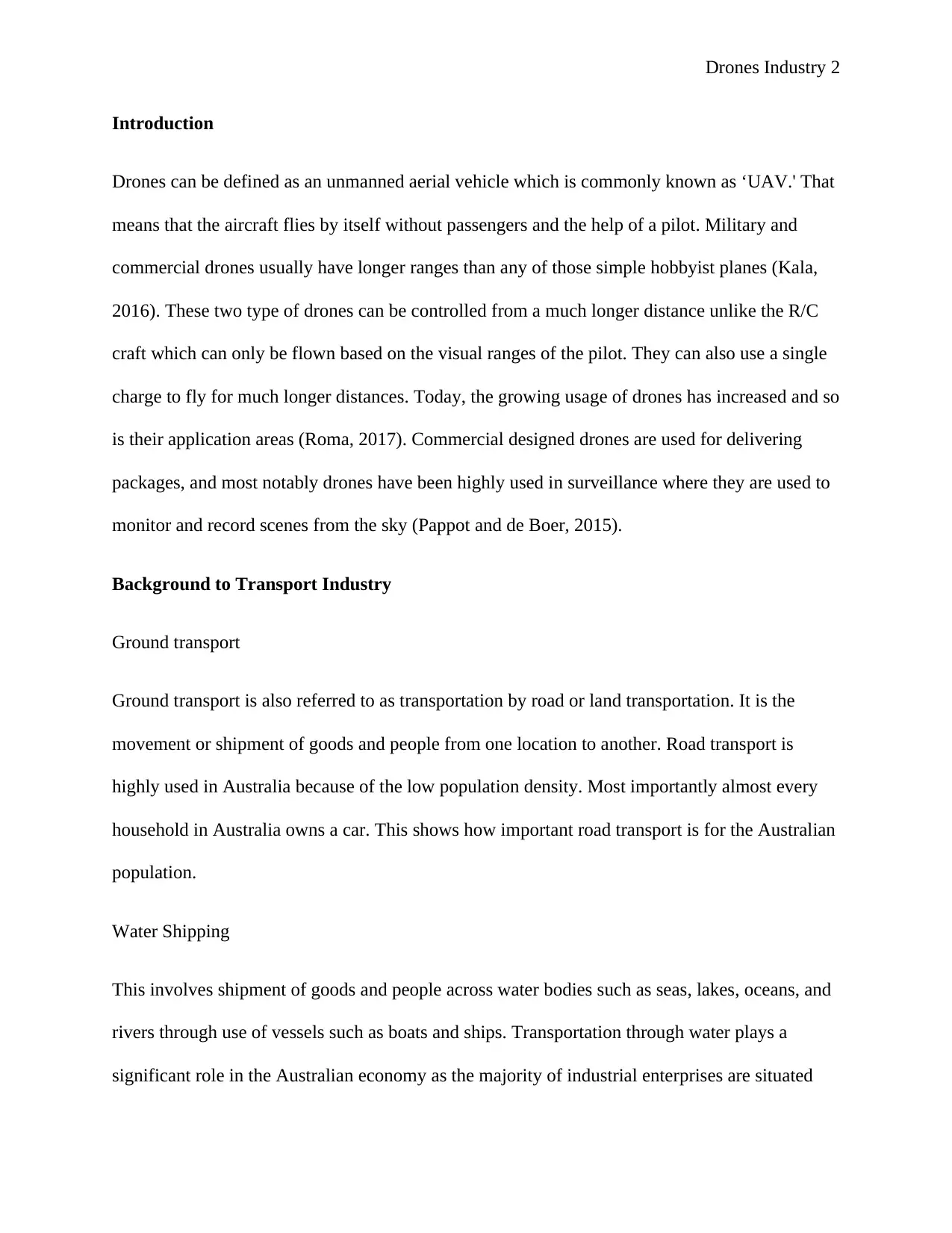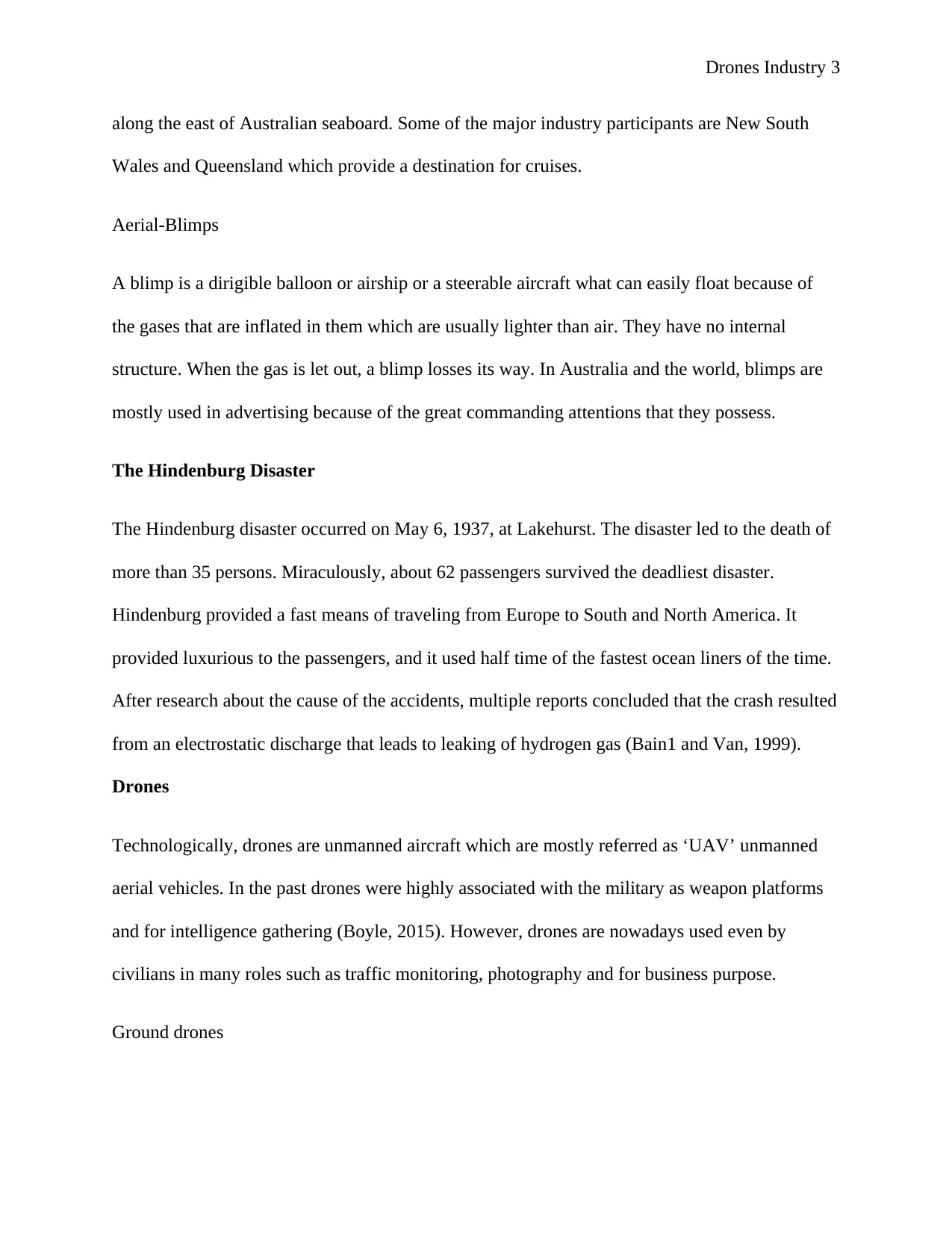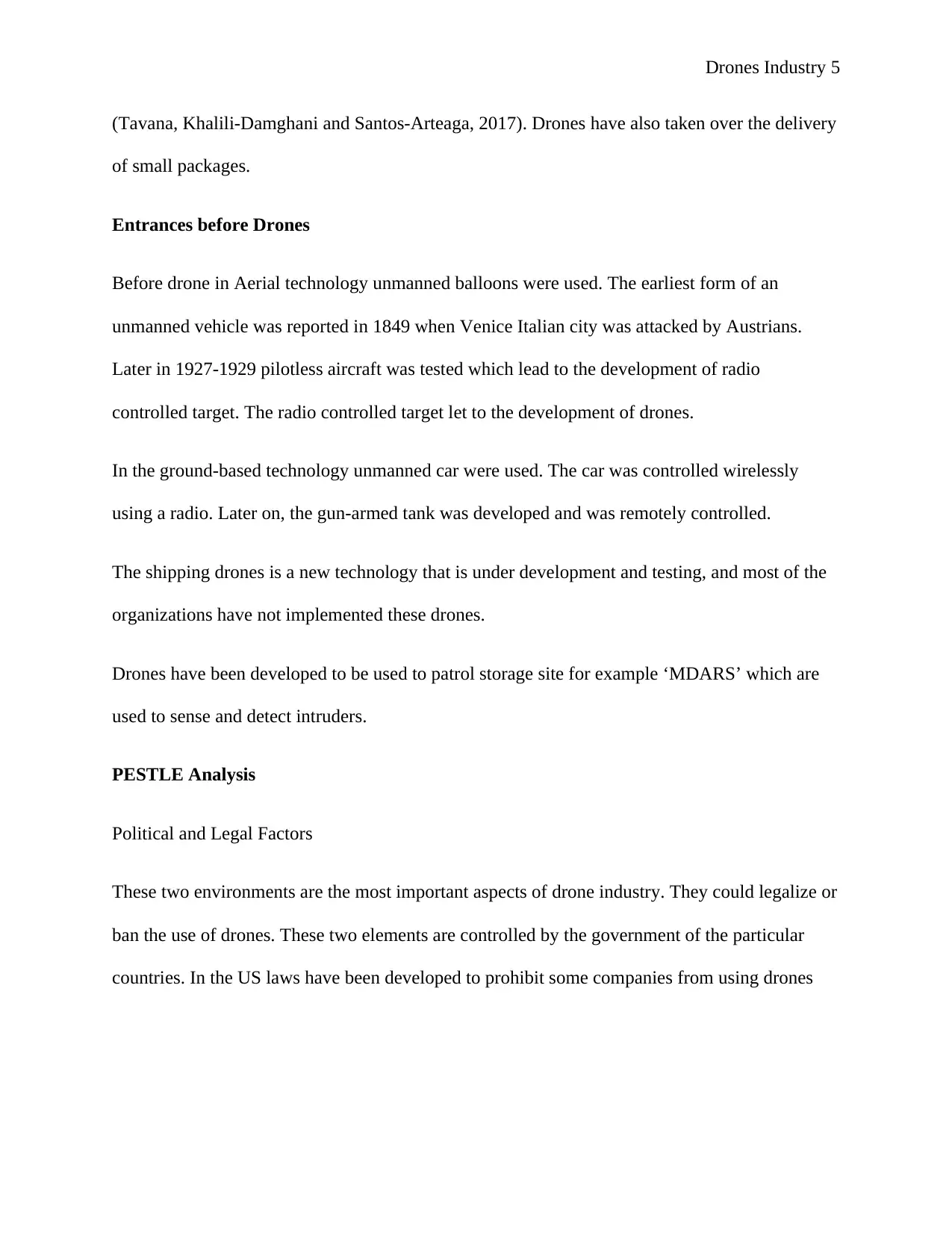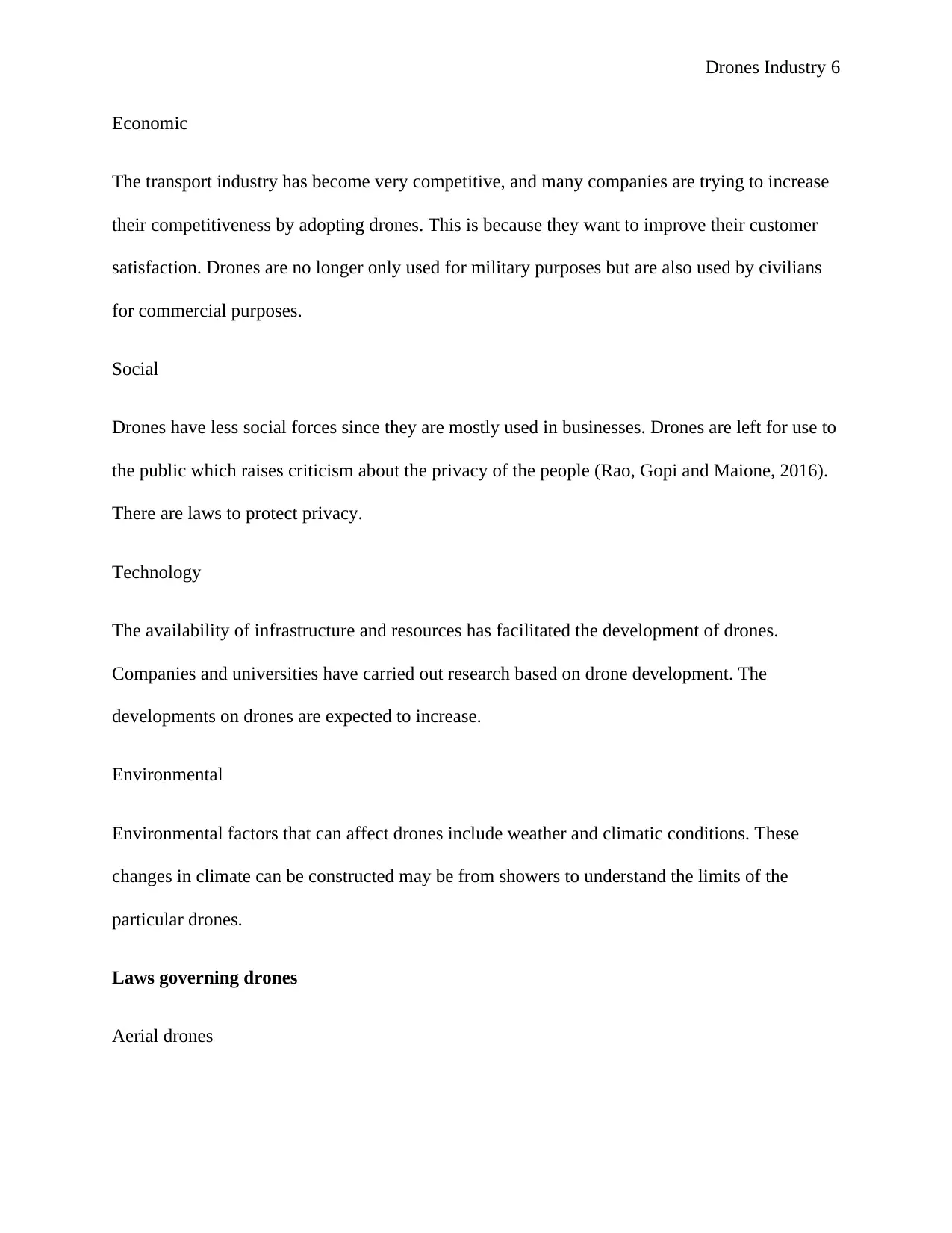Drones Industry Report
VerifiedAdded on 2019/11/14
|9
|1691
|258
Report
AI Summary
This report provides a comprehensive overview of the drone industry, focusing on its impact on the transportation sector. It begins by defining drones and their various applications, including package delivery, surveillance, and military operations. The report then examines different modes of transportation (ground, water, and air) and how drones are transforming them. A PESTLE analysis is conducted to assess the political, economic, social, technological, environmental, and legal factors influencing the drone industry. The report also discusses the legal frameworks governing drone usage in different sectors and across international waters and airspace. Finally, the report touches upon the historical development of drone technology, from early unmanned vehicles to the sophisticated systems used today. The overall tone suggests that drones are revolutionizing transportation, offering increased efficiency and flexibility, but also posing challenges related to regulation and potential threats to existing transportation businesses.

Drones Industry 1
Drones Industry
Name
Course
Professor
School
City
Date
Drones Industry
Name
Course
Professor
School
City
Date
Paraphrase This Document
Need a fresh take? Get an instant paraphrase of this document with our AI Paraphraser

Drones Industry 2
Introduction
Drones can be defined as an unmanned aerial vehicle which is commonly known as ‘UAV.' That
means that the aircraft flies by itself without passengers and the help of a pilot. Military and
commercial drones usually have longer ranges than any of those simple hobbyist planes (Kala,
2016). These two type of drones can be controlled from a much longer distance unlike the R/C
craft which can only be flown based on the visual ranges of the pilot. They can also use a single
charge to fly for much longer distances. Today, the growing usage of drones has increased and so
is their application areas (Roma, 2017). Commercial designed drones are used for delivering
packages, and most notably drones have been highly used in surveillance where they are used to
monitor and record scenes from the sky (Pappot and de Boer, 2015).
Background to Transport Industry
Ground transport
Ground transport is also referred to as transportation by road or land transportation. It is the
movement or shipment of goods and people from one location to another. Road transport is
highly used in Australia because of the low population density. Most importantly almost every
household in Australia owns a car. This shows how important road transport is for the Australian
population.
Water Shipping
This involves shipment of goods and people across water bodies such as seas, lakes, oceans, and
rivers through use of vessels such as boats and ships. Transportation through water plays a
significant role in the Australian economy as the majority of industrial enterprises are situated
Introduction
Drones can be defined as an unmanned aerial vehicle which is commonly known as ‘UAV.' That
means that the aircraft flies by itself without passengers and the help of a pilot. Military and
commercial drones usually have longer ranges than any of those simple hobbyist planes (Kala,
2016). These two type of drones can be controlled from a much longer distance unlike the R/C
craft which can only be flown based on the visual ranges of the pilot. They can also use a single
charge to fly for much longer distances. Today, the growing usage of drones has increased and so
is their application areas (Roma, 2017). Commercial designed drones are used for delivering
packages, and most notably drones have been highly used in surveillance where they are used to
monitor and record scenes from the sky (Pappot and de Boer, 2015).
Background to Transport Industry
Ground transport
Ground transport is also referred to as transportation by road or land transportation. It is the
movement or shipment of goods and people from one location to another. Road transport is
highly used in Australia because of the low population density. Most importantly almost every
household in Australia owns a car. This shows how important road transport is for the Australian
population.
Water Shipping
This involves shipment of goods and people across water bodies such as seas, lakes, oceans, and
rivers through use of vessels such as boats and ships. Transportation through water plays a
significant role in the Australian economy as the majority of industrial enterprises are situated

Drones Industry 3
along the east of Australian seaboard. Some of the major industry participants are New South
Wales and Queensland which provide a destination for cruises.
Aerial-Blimps
A blimp is a dirigible balloon or airship or a steerable aircraft what can easily float because of
the gases that are inflated in them which are usually lighter than air. They have no internal
structure. When the gas is let out, a blimp losses its way. In Australia and the world, blimps are
mostly used in advertising because of the great commanding attentions that they possess.
The Hindenburg Disaster
The Hindenburg disaster occurred on May 6, 1937, at Lakehurst. The disaster led to the death of
more than 35 persons. Miraculously, about 62 passengers survived the deadliest disaster.
Hindenburg provided a fast means of traveling from Europe to South and North America. It
provided luxurious to the passengers, and it used half time of the fastest ocean liners of the time.
After research about the cause of the accidents, multiple reports concluded that the crash resulted
from an electrostatic discharge that leads to leaking of hydrogen gas (Bain1 and Van, 1999).
Drones
Technologically, drones are unmanned aircraft which are mostly referred as ‘UAV’ unmanned
aerial vehicles. In the past drones were highly associated with the military as weapon platforms
and for intelligence gathering (Boyle, 2015). However, drones are nowadays used even by
civilians in many roles such as traffic monitoring, photography and for business purpose.
Ground drones
along the east of Australian seaboard. Some of the major industry participants are New South
Wales and Queensland which provide a destination for cruises.
Aerial-Blimps
A blimp is a dirigible balloon or airship or a steerable aircraft what can easily float because of
the gases that are inflated in them which are usually lighter than air. They have no internal
structure. When the gas is let out, a blimp losses its way. In Australia and the world, blimps are
mostly used in advertising because of the great commanding attentions that they possess.
The Hindenburg Disaster
The Hindenburg disaster occurred on May 6, 1937, at Lakehurst. The disaster led to the death of
more than 35 persons. Miraculously, about 62 passengers survived the deadliest disaster.
Hindenburg provided a fast means of traveling from Europe to South and North America. It
provided luxurious to the passengers, and it used half time of the fastest ocean liners of the time.
After research about the cause of the accidents, multiple reports concluded that the crash resulted
from an electrostatic discharge that leads to leaking of hydrogen gas (Bain1 and Van, 1999).
Drones
Technologically, drones are unmanned aircraft which are mostly referred as ‘UAV’ unmanned
aerial vehicles. In the past drones were highly associated with the military as weapon platforms
and for intelligence gathering (Boyle, 2015). However, drones are nowadays used even by
civilians in many roles such as traffic monitoring, photography and for business purpose.
Ground drones
⊘ This is a preview!⊘
Do you want full access?
Subscribe today to unlock all pages.

Trusted by 1+ million students worldwide

Drones Industry 4
This is unmanned ground vehicle ‘UGV’ which operates while in contact with the ground and
does not require a human controller. They are designed to work in dangerous environments that
are unsuitable for human operators
Shipping drones
These are unmanned aerial vehicles that are used to deliver good and small packages from one
place to another. Increased commercial use of drones has facilitated the increase of drones in this
industry. Some organization such as Amazon has invested heavily in this drones to deliver small
packages to customers faster and safely.
Aerial drones
These are Unmanned Aerial Vehicle ‘UAV’ which are aircraft without a pilot. These drones can
be controlled remotely by a controller in control station, or they can also fly autonomously on
their own (Aerial drone, 2016). These drones have many areas of application, they can be used
by the military to launch attacks, and delivery drones are used in delivering goods like they are
employed by Amazon.
Drone threats to transport industry
The increased demand and usage of drones can be thought as a threat to the industry of carriage
because of the impacts the drones will have to transportation companies which have inadequate
capital to invest in drones (Haidari, Brown and Ambikapathi, 2016). However, drones have had
an enormous impact on almost all modes of transport. In ocean carrier by use of ships and ferries
is not flexible as ports are required for ships to anchor but if drones are used, they can provide
more reliable transportation and automatically updating the transportation management system
This is unmanned ground vehicle ‘UGV’ which operates while in contact with the ground and
does not require a human controller. They are designed to work in dangerous environments that
are unsuitable for human operators
Shipping drones
These are unmanned aerial vehicles that are used to deliver good and small packages from one
place to another. Increased commercial use of drones has facilitated the increase of drones in this
industry. Some organization such as Amazon has invested heavily in this drones to deliver small
packages to customers faster and safely.
Aerial drones
These are Unmanned Aerial Vehicle ‘UAV’ which are aircraft without a pilot. These drones can
be controlled remotely by a controller in control station, or they can also fly autonomously on
their own (Aerial drone, 2016). These drones have many areas of application, they can be used
by the military to launch attacks, and delivery drones are used in delivering goods like they are
employed by Amazon.
Drone threats to transport industry
The increased demand and usage of drones can be thought as a threat to the industry of carriage
because of the impacts the drones will have to transportation companies which have inadequate
capital to invest in drones (Haidari, Brown and Ambikapathi, 2016). However, drones have had
an enormous impact on almost all modes of transport. In ocean carrier by use of ships and ferries
is not flexible as ports are required for ships to anchor but if drones are used, they can provide
more reliable transportation and automatically updating the transportation management system
Paraphrase This Document
Need a fresh take? Get an instant paraphrase of this document with our AI Paraphraser

Drones Industry 5
(Tavana, Khalili-Damghani and Santos-Arteaga, 2017). Drones have also taken over the delivery
of small packages.
Entrances before Drones
Before drone in Aerial technology unmanned balloons were used. The earliest form of an
unmanned vehicle was reported in 1849 when Venice Italian city was attacked by Austrians.
Later in 1927-1929 pilotless aircraft was tested which lead to the development of radio
controlled target. The radio controlled target let to the development of drones.
In the ground-based technology unmanned car were used. The car was controlled wirelessly
using a radio. Later on, the gun-armed tank was developed and was remotely controlled.
The shipping drones is a new technology that is under development and testing, and most of the
organizations have not implemented these drones.
Drones have been developed to be used to patrol storage site for example ‘MDARS’ which are
used to sense and detect intruders.
PESTLE Analysis
Political and Legal Factors
These two environments are the most important aspects of drone industry. They could legalize or
ban the use of drones. These two elements are controlled by the government of the particular
countries. In the US laws have been developed to prohibit some companies from using drones
(Tavana, Khalili-Damghani and Santos-Arteaga, 2017). Drones have also taken over the delivery
of small packages.
Entrances before Drones
Before drone in Aerial technology unmanned balloons were used. The earliest form of an
unmanned vehicle was reported in 1849 when Venice Italian city was attacked by Austrians.
Later in 1927-1929 pilotless aircraft was tested which lead to the development of radio
controlled target. The radio controlled target let to the development of drones.
In the ground-based technology unmanned car were used. The car was controlled wirelessly
using a radio. Later on, the gun-armed tank was developed and was remotely controlled.
The shipping drones is a new technology that is under development and testing, and most of the
organizations have not implemented these drones.
Drones have been developed to be used to patrol storage site for example ‘MDARS’ which are
used to sense and detect intruders.
PESTLE Analysis
Political and Legal Factors
These two environments are the most important aspects of drone industry. They could legalize or
ban the use of drones. These two elements are controlled by the government of the particular
countries. In the US laws have been developed to prohibit some companies from using drones

Drones Industry 6
Economic
The transport industry has become very competitive, and many companies are trying to increase
their competitiveness by adopting drones. This is because they want to improve their customer
satisfaction. Drones are no longer only used for military purposes but are also used by civilians
for commercial purposes.
Social
Drones have less social forces since they are mostly used in businesses. Drones are left for use to
the public which raises criticism about the privacy of the people (Rao, Gopi and Maione, 2016).
There are laws to protect privacy.
Technology
The availability of infrastructure and resources has facilitated the development of drones.
Companies and universities have carried out research based on drone development. The
developments on drones are expected to increase.
Environmental
Environmental factors that can affect drones include weather and climatic conditions. These
changes in climate can be constructed may be from showers to understand the limits of the
particular drones.
Laws governing drones
Aerial drones
Economic
The transport industry has become very competitive, and many companies are trying to increase
their competitiveness by adopting drones. This is because they want to improve their customer
satisfaction. Drones are no longer only used for military purposes but are also used by civilians
for commercial purposes.
Social
Drones have less social forces since they are mostly used in businesses. Drones are left for use to
the public which raises criticism about the privacy of the people (Rao, Gopi and Maione, 2016).
There are laws to protect privacy.
Technology
The availability of infrastructure and resources has facilitated the development of drones.
Companies and universities have carried out research based on drone development. The
developments on drones are expected to increase.
Environmental
Environmental factors that can affect drones include weather and climatic conditions. These
changes in climate can be constructed may be from showers to understand the limits of the
particular drones.
Laws governing drones
Aerial drones
⊘ This is a preview!⊘
Do you want full access?
Subscribe today to unlock all pages.

Trusted by 1+ million students worldwide

Drones Industry 7
Some of the laws that guide the drone users not to fly beyond 400 feet, the drones should be
flown within sight of the controller, drones are prohibited to be flown over groups of people such
as stadiums.
Ground based drones
The laws prohibit the drone controllers from ‘driving’ the drones at night. Drones should also
not be controlled beyond the sight of the driver, and the drones should not violate the established
ground regulations such as road regulations.
Shipping Drones
According to the proposed laws, people can only be allowed to fly only the registered drones,
and they should not weigh beyond 25kgs. This means that the packages should not be large or
should not weigh more.
The controller should have a minimum of 17 years and should pass aeronautics test.
International waters and International Airspace
The term international waters apply where water bodies transcend international bounders such as
oceans. A country has no sovereignty over international waters. All countries have rights and
freedom of navigation (Vacca and Onishi, 2017). While international airspace is the airspace that
is not restricted to territorial rules of any country.
Some of the laws that guide the drone users not to fly beyond 400 feet, the drones should be
flown within sight of the controller, drones are prohibited to be flown over groups of people such
as stadiums.
Ground based drones
The laws prohibit the drone controllers from ‘driving’ the drones at night. Drones should also
not be controlled beyond the sight of the driver, and the drones should not violate the established
ground regulations such as road regulations.
Shipping Drones
According to the proposed laws, people can only be allowed to fly only the registered drones,
and they should not weigh beyond 25kgs. This means that the packages should not be large or
should not weigh more.
The controller should have a minimum of 17 years and should pass aeronautics test.
International waters and International Airspace
The term international waters apply where water bodies transcend international bounders such as
oceans. A country has no sovereignty over international waters. All countries have rights and
freedom of navigation (Vacca and Onishi, 2017). While international airspace is the airspace that
is not restricted to territorial rules of any country.
Paraphrase This Document
Need a fresh take? Get an instant paraphrase of this document with our AI Paraphraser

Drones Industry 8
References
BIBLIOGRAPHY Aerial drone., 2016. 57. Retrieved from https://doi.org/10.1016/S0262-4079(16)31855-3
Bain, A. and Van Vorst, W.D., 1999. The Hindenburg tragedy revisited:: the fatal flaw found.
International Journal of Hydrogen Energy, 24(5), pp.399-403.
Retrieved from https://doi.org/10.1016/S0360-3199(98)00176-1
Boyle, M. J., 2015. The Race for Drones. Orbis, 59(1), 76-94.
Haidari, Brown and Ambikapathi., 2016. The economic and operational value of using drones to
transport vaccines. 4062-4067.
Kala, R., 2016. 1 – Introduction. 1-10. Retrieved from https://doi.org/10.1016/B978-0-12
803729-4.00001-5
Pappot and de Boer., 2015. The Integration of Drones in Today's Society. 54-63. Retrieved from
https://doi.org/10.1016/j.proeng.2015.11.504
Rao, Gopi & Maione. (2016). The societal impact of commercial drones. 83-90.
Roma, A., 2017. Drones and popularisation of space. 23-30. Retrieved from
ttps://doi.org/10.1016/j.spacepol.2017.01.001
Tavana, Khalili-Damghani and Santos-Arteaga., 2017. Drone shipping versus truck delivery in a
cross-docking system with multiple fleets and products. 93-107.
Vacca and Onishi., 2017. Drones. military weapons, surveillance or mapping tools for
environmental monitoring? The need for legal framework is required, 51-62.
References
BIBLIOGRAPHY Aerial drone., 2016. 57. Retrieved from https://doi.org/10.1016/S0262-4079(16)31855-3
Bain, A. and Van Vorst, W.D., 1999. The Hindenburg tragedy revisited:: the fatal flaw found.
International Journal of Hydrogen Energy, 24(5), pp.399-403.
Retrieved from https://doi.org/10.1016/S0360-3199(98)00176-1
Boyle, M. J., 2015. The Race for Drones. Orbis, 59(1), 76-94.
Haidari, Brown and Ambikapathi., 2016. The economic and operational value of using drones to
transport vaccines. 4062-4067.
Kala, R., 2016. 1 – Introduction. 1-10. Retrieved from https://doi.org/10.1016/B978-0-12
803729-4.00001-5
Pappot and de Boer., 2015. The Integration of Drones in Today's Society. 54-63. Retrieved from
https://doi.org/10.1016/j.proeng.2015.11.504
Rao, Gopi & Maione. (2016). The societal impact of commercial drones. 83-90.
Roma, A., 2017. Drones and popularisation of space. 23-30. Retrieved from
ttps://doi.org/10.1016/j.spacepol.2017.01.001
Tavana, Khalili-Damghani and Santos-Arteaga., 2017. Drone shipping versus truck delivery in a
cross-docking system with multiple fleets and products. 93-107.
Vacca and Onishi., 2017. Drones. military weapons, surveillance or mapping tools for
environmental monitoring? The need for legal framework is required, 51-62.

Drones Industry 9
⊘ This is a preview!⊘
Do you want full access?
Subscribe today to unlock all pages.

Trusted by 1+ million students worldwide
1 out of 9
Your All-in-One AI-Powered Toolkit for Academic Success.
+13062052269
info@desklib.com
Available 24*7 on WhatsApp / Email
![[object Object]](/_next/static/media/star-bottom.7253800d.svg)
Unlock your academic potential
Copyright © 2020–2025 A2Z Services. All Rights Reserved. Developed and managed by ZUCOL.
